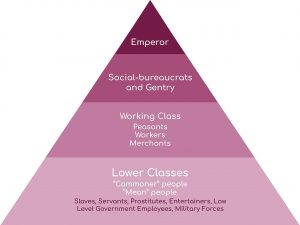The Qing Dynasty was China’s last Manchu-led imperial dynasty, reigning from 1644 to 1911. The period was regarded as prosperous in its early years but chaotic towards the end. It was the second time the country was ruled by another ethnic group other than the Han Chinese.
The social structure was based on Confucian philosophy and placed the emperor and the imperial family at the top of the hierarchy as part of an integrated bureaucracy. Power was concentrated at the highest level of the social structure and trickled down to the lower levels. The emperor was followed by the government officials, who also had their order from imperial officials to the local magistrate referred to as the yamen. Government officials’ ranks were contingent on their results from the government examinations, which the Chinese could be the first to employ as a basis for their officials. The candidates for these exams spent years studying Confucian philosophy to pass the tests on national, provincial, and local levels.
Then the landlords and agriculturists were next in line, and the peasants and farmers followed them. Lastly, the lower class of the Qing dynasty consisted of outcasts such as criminals and vagrants.
The Emperor
Unlike traditional monarchy that promotes absolute power, the emperor of China was believed to be a “perfect” ruler, a sage king according to Confucian teachings. The populace had high expectations for their emperor because they were considered the “son of god” and possessed the Mandate of Heaven, allowing him to control the cosmic forces. If they were overthrown or if any calamity or famine would happen in China, the emperor could be considered to have lost the Mandate. Whoever gained control of the country was understood to then have the Mandate, just as when the Ming Dynasty conceded to the Qing Dynasty.
The emperor and his immediate family, the imperial family, were at the top of the hierarchy. They came into power because the Ming Dynasty allied with the Manchu army when they were under the attack of the rebel Li Zicheng in 1644. Once the Manchus triumphed over Li Zicheng, they established their leadership in Beijing through the Qing Dynasty, inheriting the Mandate of Heaven. The Manchu imperial family continued Han ideals and Confucian philosophy, which appealed to the Han people and kept them in power.
Government Officials
The class of government that benefited from the class structure were the government officials, also called the gentry class. They possessed lands and gained wealth from their businesses and harvests through these locations. To become a part of the Gentry, one had to pass the civil service exams. This was unlike government members in other countries at the time that were given titles due to their lineage. Their positions were instead attained through a meritocracy based on the points they achieved in their exams, the most well-known test being the “Eight-legged essay.” Numerous candidates spent years studying for this exam which even the wealthiest members of society found challenging to pass. Some opted to buy certificates to obtain higher statuses. Examples of these officials were the political leaders Hong Rengan and Feng Yunshan.
Many of the social bureaucrats were tasked to implement public projects on behalf of the government as well as keep order in society. They wore insignias that displayed their rankings to the common folk and were addressed with specific honorific titles.
The author of Elite Activism and Political Transformation in China, Mary Rankin, wrote about the Taiping rebellion from 1850 to 1864 and its effects on the gentry class. The movement was initiated due to the civil service exam candidate Hong Xiuquan who thought he was the son of god and formed a rebel religious force. This impacted the gentry class by empowering them to participate in social mobilization, political development, and elite activism. This also fused the gentry class with the merchant class.
Agricultural Class
Under the level of the Gentry were the common people who earned their means through agriculture. This level was further divided into two classes: those who were landlords and those who were tenant farmers or laborers. The former owned the lands that were used to plant and harvest crops, while the latter worked in the fields for the food of their countrymen.
The agricultural class rebelled several times at the start of the Qing Dynasty due to famines and calamities that prevented them from collecting bountiful harvests. The government officials formulated a granary system that subsidized the people with grain during these disasters. In the 1850s, this system was dismantled due to the Taiping rebellion. As a result, the population was left to consume sweet potatoes during calamities.
Merchants and Artisans
Merchants were an entire class that was divided between street sellers and wealthy entrepreneurs. Despite being at a financial advantage, all merchants were regarded as lower than farmers in Confucian philosophy because they were regarded as useless and corrupt. They were perceived to bribe officials so their children could pass the civil service exams. Meanwhile, artisans such as painters, crafters, poets, and potters were employed by the government or by the gentry. Thus, they also usually had a larger income than their agricultural counterparts.
Lower classes
The lower classes consisted of the “commoners and the outcasts of society such as slaves, entertainers, prostitutes, criminals, and servants. Outcasts were mostly discriminated against; they were not allowed to advance in society by taking the civil service exams. However, inheriting slave status upon birth was eradicated throughout the Qing dynasty. Furthermore, even within their class, commoners and outcasts could not marry.
Military Class
During the Qing Dynasty, the White Lotus Rebellion grew in popularity; they were composed of Han Chinese who wanted to abolish Manchu rule and reinstate the Ming dynasty. The group caused the Qing dynasty to mobilize the locals to become part of the military against the White Lotus. Thus, the military-predatory elite class rose from this process.
